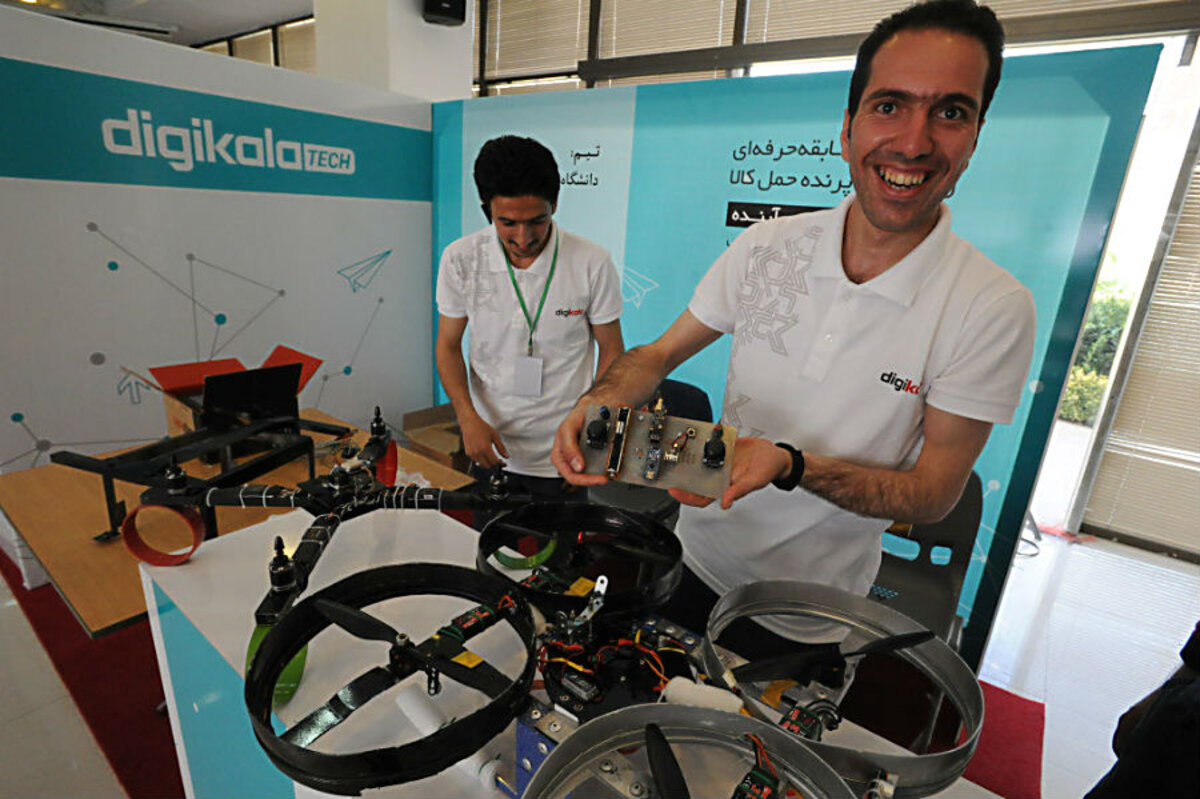With civilian drone competition, Iran battles against brain drain
Loading...
| Tehran
The 26 drone-building teams descended on the polished, manicured technology park 15 miles east of Tehran with the overflowing enthusiasm of school kids preparing for the Science Olympiad.
Their challenge, in a competition sponsored by the fast-growing Digikala company, Iran’s version of Amazon, was to create the best drone for delivering packages.
For the drone builders, the prize that day at Pardis Technology Park, Iran’s purpose-built version of Silicon Valley, was 50 million tomans, or about $14,300. But for Iran, the goal was much greater: a step toward providing the country’s whiz-kid youth with the hope that they have a future in Iran.
The teams assembled their flying contraptions with everything from carbon fiber frames and propellers to homemade radio controls and imaging units bursting with wires. The drones had to carry a 2-kg (4.4 lbs) courier package for 700 meters (765 yards), avoiding obstacles and dropping it gently on one of four bar-code emblazoned targets.
The only casualty was a drone flown by the Amir Kabir University of Technology robotic center that struck a balloon and crashed. But it was flying again within an hour, and became one of three joint winners.
The drone challenge posed by Digikala, which handles more than 90 percent of Iran’s online commerce, is similar to the technical problems faced by Amazon, DHL, and others as they seek innovative ways to speed deliveries.
But the competition organizers say the event was about more than marshaling Iran’s brightest young minds to some day bypass Tehran’s notorious traffic jams with a fleet of Iran-built commercial drones. It was also about stemming the broader problem of a brain drain, even as Iran’s annual legion of university graduates struggles to find jobs.
“The main reason of the contest is to recognize the high potential of youth here,” says Babak Moghaddam, the head of innovation at Digikala, as the teams assembled their drones. “Many leave the country.”
That’s one reason the three winning teams – two university groups and one drone-making start-up from Tehran – are to join forces into a single “golden team” for Digikala that starts laboratory work next December.
Losing 'educated brains'
While Amazon and DHL focus on in-house drone creation, Digikala has chosen a different model based on what it calls “open innovation and crowd sourcing” to pool creative talent.
“It helps, seriously. But we need a lot of these competitions and more investment to help people think of living in Iran,” says Reza Kalantarinejad, a competition jury member and founder of Shezan, a biotech and nanotechnology company.
“It’s a chance, it helps people have a belief in the future of Iran and high-tech,” says Mr. Kalantarinejad. “Such tech development helps keep people here.”
Anything that eases Iran’s chronic brain drain is welcomed by officials, who have struggled to find solutions. The former minister of Science, Research, and Technology, Reza Farajidana, has estimated that 150,000 “educated brains” leave the country each year, calculating the cost to Iran to be tens of billions annually.
Official statistics in 2012 indicated that 64 percent of Iran’s International Science Olympiad winners in the previous 14 years had left the country. Another official source that year stated that 90 of Iran’s 125 medal winners from 2008 to 2011 had immigrated to the US.
“The problem will lead Iran toward becoming a nation void of intelligent genes,” lamented Hamid Mirzadeh, the head of Islamic Azad University in 2014.
The Digikala success story
One way the government is trying to check the flow is supporting projects like the Pardis Technology Park, which aims to nurture high-tech and start-ups. The compound, carved out of desert along the highway, has streets with names like “Innovation.” The board of trustees is headed by an Iranian vice president and includes the president’s deputy for science and research.
After an initial private investment, which made space for some 200 science-based companies, an expansion is under way that officials hope will eventually create 5,000 jobs.
Among the success stories they would like to recreate is Digikala, which has experienced exponential growth, jumping from 250 to more than 1,900 employees in the past two years alone. Digikala sells more than 100,000 items online, to between 1.4 million and 1.7 million unique visitors each day, but the challenges of getting purchases to customers in real time are technical – and fraught with security restrictions.
Even getting the contest approved required extensive meetings with officials, both civilian and from Iran’s security forces, anxious about having drones in the air that they don’t control.
“This is only the first step; we have a long way to go,” says Digikala’s Mr. Moghaddam. “We need to convince the government and police it is not a threat but a tool for customer satisfaction.”
'Ready for the future'
Iran’s drone exploits are best known for the intact capture of an American RQ-170 Stealth drone on a CIA spying mission over Iran in December 2011. Unveiling new military drone capabilities in mid-September, Iran’s Army chief said drones were the “sharp eyes and far-reaching arms” of his forces. In August, Iran presented a new drone it said was designed for “jamming and deception operations.”
Such experience by Iran’s military – as well as fielding reconnaissance drones in Syria, Iraq, and other battlefields – has made launching commercial drone use a particular challenge.
“The government has two faces,” says Moghaddam. “It wants to follow these trends and show that Iran is modern, but it also wants to be careful for security and safety reasons. In the end we should not fight the technology, we should use it.… We should be ready for the future.”
And that is exactly what the drone competition teams aimed to achieve, as they prepared their creations for flight.
Mostafa Moffarah of Falcon Delivery Drones – the Tehran start-up that placed in the top three – tinkered with his six-rotor drone and explained that improving flight time and boosting payload were priorities.
And as his drone took off, Farzad Ahmadinejad – an electrical engineering graduate from Amir Kabir – worried about the on-board computer and vision system meant to prevent collisions.
“We have an attitude in our country, ‘You can’t do it,’ ” says Mehran Ahmadi, a competition organizer for Digilaka with a background in robotics. “But we are showing that you can. For people to stay in the country and solve problems, and to think, ‘If we can solve this, maybe we can solve other problems.’ ”





